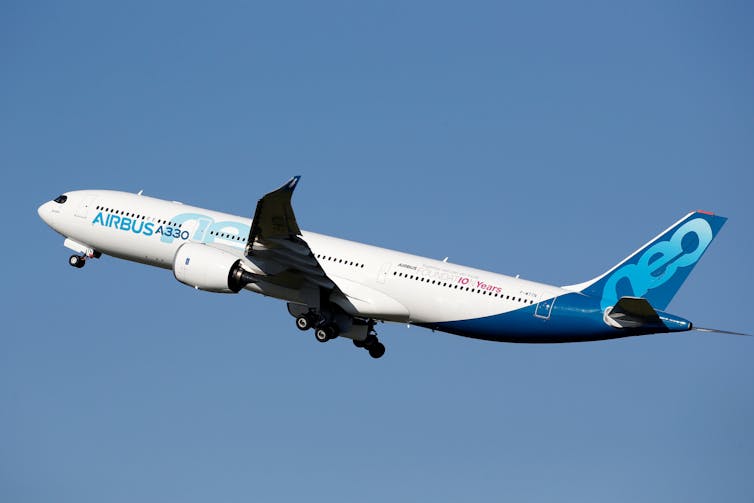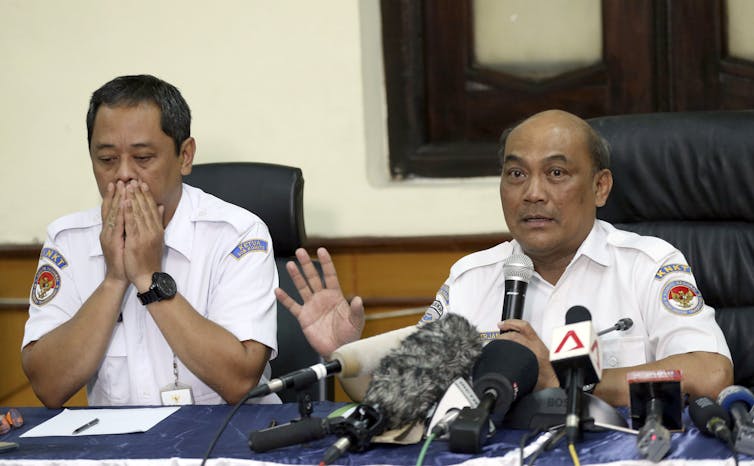Boeing 737 Max: The FAA wanted a safe plane – but didn't want to hurt America’s biggest exporter either
- Written by Susan Webb Yackee, Professor of Political Science, University of Wisconsin-Madison
Recent incidents aside, air travel is incredibly safe[1] these days.
Global airplane fatalities averaged 840 a year[2] from 2010 to 2018, compared with almost 2,000 in the 1990s. In fact, this decade is on pace to see the fewest casualties since the dawn of jet travel in the 1930s.
Yet the March 10 crash[3] of Ethiopian Airlines Flight 302 serves as a stark reminder that despite the significant safety gains in commercial aviation, accidents are still possible. And when they occur, the number of fatalities is often large.
What makes the most recent crash particularly concerning is that the airplane design may have played a significant contributing role[4]. Perhaps even worse, there are early indications that regulators at the Federal Aviation Administration – the agency that oversees the development and certification of all U.S. airplanes – may have been more concerned about bringing the Boeing 737 Max to market[5] than about consumer safety.
As a result, observers have accused[6] the FAA of being too cozy with Boeing. And transportation officials in both the U.S.[7] and Canada[8] plan to review how the plane got certified to fly by the FAA.
As experts on the regulatory process, we see this as a tragic example of what happens when an agency must balance competing goals[9]. The FAA was supposed to protect air travelers and regulate aircraft makers. At the same time, it doesn’t want to make it harder for companies like Boeing to make money in a very competitive global market.
And a heated rivalry is exactly where Boeing’s current troubles began.
Competing in a global market
The global market for jetliners has been dominated by two major competitors: Boeing and Airbus[10]. Since the 1990s, they’ve been in a bruising battle over market share.
Competition has been particularly fierce in the narrow-body or single-aisle aircraft market. This segment historically has made up about two-thirds of deliveries for both Airbus[11] and Boeing[12]. It also holds significant growth potential[13] in the future. Altogether, they have sold and delivered almost 20,000 aircraft[14] from the A320 or 737 families since their respective launches in the 1970s and 1980s.
When one company gains even a slight edge by offering a more efficient product, the implications can be massive. This occurred with the highly successful launch of the Airbus 320neo in 2010[15]. The cost savings from reduced fuel consumption proved so significant that even American Airlines[16], an exclusive Boeing customer at the time, ordered several hundred 320neos. Fuel is the second-highest expense for airlines after labor[17].
 The Airbus 320neo led Boeing to develop the 737 Max.
Reuters/Regis Duvignau[18]
The Airbus 320neo led Boeing to develop the 737 Max.
Reuters/Regis Duvignau[18]
Boeing playing catch-up
Falling behind its rival, Boeing felt the need to update its 737 family. And it had to do it fast, particularly with regard to fuel efficiency[19].
So Boeing decided to alter the position of the plane’s engines. But doing so changed the plane’s aerodynamics in a way that could cause the plane’s nose to tip upward into a stall, which is what appears to have happened repeatedly before the recent crashes.
Boeing sought to solve this engineering problem using an automated correction system[20] known as MCAS. A malfunction of this system[21] may have contributed to the crashes of Ethiopian Airlines Flight 302[22] and Indonesian Lion Air Flight 610[23] in October – although investigations are ongoing.
Boeing has put out a statement[24] saying that it working with investigators to determine the cause of the crash.
The FAA and the Boeing 737 Max 8
Even before these incidents, there were concerns[25] that the FAA was delegating too much safety oversight to Boeing itself.
The FAA allowed Boeing to handle much of the safety certification process[26], and Congress supported doing so[27] – though recent events may be prompting lawmakers to change their tune[28]. Reports have suggested that Boeing even excluded FAA technical experts[29] from some of those decisions.
In addition, recent analyses suggest that Boeing made several misjudgments when it designed MCAS[30] and hasn’t been fully forthcoming[31] with both the FAA and airlines about how it worked. The airline has also been accused of providing inadequate training for pilots.
 The National Transportation Safety Committee Chairman Soerjanto Tjahjono, right, spoke about a third troubled Boeing flight.
AP Photo/Achmad Ibrahim[32]
The National Transportation Safety Committee Chairman Soerjanto Tjahjono, right, spoke about a third troubled Boeing flight.
AP Photo/Achmad Ibrahim[32]
‘Regulatory capture’ at the FAA?
This has led critics to argue[33] that the FAA has gotten too close to the entity it was supposed to oversee.
This situation – when regulatory agencies created to protect the public interest become overly entangled with commercial and special interests – is known as “regulatory capture[34].” Many see this as corrosive for society[35]. The 2010 Deep Water Horizon oil explosion[36], the largest marine spill in history[37], is considered an example of this.
Yet, capture is difficult to prove[38], especially in an era when businesses must work closely with government to ensure that agency officials have the best and latest technical information to develop and issue appropriate regulations.
During this process, public regulators are supposed to act in the “public interest.” However, the term is inherently vague and open to a multitude of competing interpretations. Unless it involves outright bribes or other corrupt activities, business influence on regulators fails to amount to criminal conduct.
To us, it seems that the FAA was simply caught in an impossible position between the competing goals of protecting consumers and protecting American business interests. In this case, the pendulum may have swung too far to the side of the latter.
Unquestionably, we want our airplanes to be safe. And, to be clear, we believe Boeing does[39] as well. Yet we also want American companies to be successful, and regulations are inherently costly and time-consuming for businesses[40], many of which are competing with companies worldwide.
It is not surprising that Boeing was eager to move forward with the 737 Max as fast as possible. Nor is it surprising that the FAA and other regulatory bodies are hesitant to impose excessive burdens on American companies – particularly on one of the nation’s premier exporters[41].
And generally, business interests tend to be much more successful[42] in obtaining their preferred regulatory outcomes than public interest groups. Our own recent work shows that the White House – regardless which party controls it – is more likely to interfere[43] with regulations coming out of more liberal and arguably pro-regulatory agencies.
The pendulum keeps swinging
The existence of competing incentives confronting regulatory agencies is nothing new. Public agencies must serve a multitude of goals and objectives and somehow find an appropriate balance.
Yet, at times, the balancing act by public agencies may tilt too far in one direction. And unfortunately, when the imbalance occurs at agencies tasked with protecting public safety, the consequences can be exceedingly dire.
It seems likely that increased public scrutiny in the wake of the two crashes may force the FAA to take a more aggressive stance on the side of consumer safety in the future. Eventually, however, business interests are likely to begin pushing back, and once again the pendulum will swing the other way.
References
- ^ is incredibly safe (www.usatoday.com)
- ^ Global airplane fatalities averaged 840 a year (www.baaa-acro.com)
- ^ March 10 crash (www.cnn.com)
- ^ may have played a significant contributing role (www.washingtonpost.com)
- ^ about bringing the Boeing 737 Max to market (medium.com)
- ^ observers have accused (www.washingtonexaminer.com)
- ^ transportation officials in both the U.S. (www.cnbc.com)
- ^ Canada (www.cnbc.com)
- ^ balance competing goals (www.amazon.com)
- ^ Boeing and Airbus (www.cnbc.com)
- ^ Airbus (www.airbus.com)
- ^ Boeing (www.boeing.com)
- ^ significant growth potential (www.planestats.com)
- ^ 20,000 aircraft (www.forbes.com)
- ^ highly successful launch of the Airbus 320neo in 2010 (www.airbus.com)
- ^ American Airlines (www.nytimes.com)
- ^ second-highest expense for airlines after labor (www.investopedia.com)
- ^ Reuters/Regis Duvignau (pictures.reuters.com)
- ^ particularly with regard to fuel efficiency (www.newyorker.com)
- ^ automated correction system (theaircurrent.com)
- ^ malfunction of this system (www.seattletimes.com)
- ^ Ethiopian Airlines Flight 302 (www.reuters.com)
- ^ Indonesian Lion Air Flight 610 (www.nytimes.com)
- ^ has put out a statement (boeing.mediaroom.com)
- ^ there were concerns (www.seattletimes.com)
- ^ handle much of the safety certification process (www.seattletimes.com)
- ^ supported doing so (fortune.com)
- ^ change their tune (chicago.cbslocal.com)
- ^ even excluded FAA technical experts (www.seattletimes.com)
- ^ Boeing made several misjudgments when it designed MCAS (www.seattletimes.com)
- ^ hasn’t been fully forthcoming (www.seattletimes.com)
- ^ AP Photo/Achmad Ibrahim (www.apimages.com)
- ^ critics to argue (fortune.com)
- ^ regulatory capture (law.emory.edu)
- ^ as corrosive for society (tobinproject.org)
- ^ Deep Water Horizon oil explosion (www.newsweek.com)
- ^ largest marine spill in history (www.britannica.com)
- ^ capture is difficult to prove (www.cambridge.org)
- ^ Boeing does (www.boeing.com)
- ^ costly and time-consuming for businesses (www.mercatus.org)
- ^ nation’s premier exporters (www.seattletimes.com)
- ^ business interests tend to be much more successful (www.cambridge.org)
- ^ is more likely to interfere (doi.org)
Authors: Susan Webb Yackee, Professor of Political Science, University of Wisconsin-Madison


